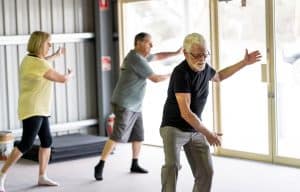Getting a Parkinson’s disease diagnosis can be overwhelming. This neurodegenerative disorder affects movement and doesn’t have a cure, but with the right medications and complementary or alternative therapies, symptoms can be managed.
Incorporating medication-free ways into Parkinson’s treatment can help people living with the condition improve their health and well-being, along with preserving physical function and enhancing quality of life.
Music therapy
A 2015 study published in Frontiers in Neurology found that playing and listening music can be beneficial for managing the movement and emotional aspects of Parkinson’s disease. Rhythm enhances connections between the motor and auditory systems, and areas that involve rhythm perception are closely related to those that regulate movement. A regular rhythmic pulse stimulates activity in the putamen, a part of the brain that is involved in learning and motor control. Rhythm also influences the kinetic system and facilitates movement synchronization, coordination, and regularization.
Another study that is being conducted by the University of Colorado School of Medicine is examining the effects of therapeutic instrumental music performance (TIMP) on Parkinson’s patients. TIMP uses specific movement and rhythm combinations to “reprogram” certain brain frequencies.
According to one of the study conductors, Parkinson’s most likely affects beta frequencies, which are generated when the brain is actively engaged in mental activities. The concept behind the study is to use external rhythms to target beta frequencies and restore them to homeostasis.
The study divides participants into four groups: one that gets no therapy, one that gets standard-of-care occupational therapy, one that gets neurologic music therapy (NMT) in which the patient dictates the rhythm through their own movements, and one that gets NMT in which the rhythm is dictated by a metronome.
The main researcher for the study hypothesizes that patients in the metronome group will see the most improvement. The theory is that the “external rhythmic cueing” of the metronome bypasses certain damaged neural pathways in Parkinson’s patients and helps the motor brain execute a proper movement sequence.
 In the study, music therapists work with patients three times a week. Each therapy session starts with dexterity exercises and rhythmic hand and finger movements. Patients use small percussive instruments called castanets and weighted keyboards to help increase fine motor skills and dexterity. Patients practice the exercises at home the other four days of the week.
In the study, music therapists work with patients three times a week. Each therapy session starts with dexterity exercises and rhythmic hand and finger movements. Patients use small percussive instruments called castanets and weighted keyboards to help increase fine motor skills and dexterity. Patients practice the exercises at home the other four days of the week.
The researchers will measure finger dexterity through a “grooved pegboard test” that requires patients to rotate 25 pegs into certain positions to be placed correctly. The researchers will also measure anxiety and depression levels, as well as quality of life.
Literature shows that playing and listening to music can modulate emotions. Sound is a means of communication and can promote emotional expression and regulation. Making and listening to music can also be considered a strong stimulus from an emotional point of view, so it can help with uplifting patients’ moods.
Light therapy
Specialized light therapy can help improve Parkinson’s symptoms such as daytime sleepiness, fatigue, tremor, and mood disorders. It can also help improve swallowing, chewing, and urinary problems.
In one study, patients who received specialized light therapy saw an improvement of 17.7 points on the MDS-Unified Parkinson’s Disease Rating Scale (MDS-UPDRS). This scale monitors the response to medications used to decrease the signs and symptoms of Parkinson’s disease.
Clinical studies have also confirmed the safety and effectiveness of light in improving insomnia and daytime sleepiness in Parkinson’s patients. One study of Parkinson’s patients with sleep disorders found that stronger light had a more significant treatment effect.
It isn’t exactly clear how exposure to bright light affects the body’s biology to regulate sleep. It is believed that it helps improve circadian rhythm, which is the body’s natural clock that regulates sleep and metabolism.
Diet
 Although there isn’t a specific diet for Parkinson’s disease, certain dietary changes can help ease the symptoms. You can work with your physician or a dietitian to design a balanced and healthy diet.
Although there isn’t a specific diet for Parkinson’s disease, certain dietary changes can help ease the symptoms. You can work with your physician or a dietitian to design a balanced and healthy diet.
Foods that are high in antioxidants can help reduce “oxidative stress” that can worsen Parkinson’s disease and other movement disorders. Foods that are high in antioxidants include:
- Berries, such as blueberries, blackberries, and cranberries
- Nightshade plants, such as tomatoes, eggplant, potatoes, and peppers
- Spinach and kale
- Tree nuts, such as walnuts, pecans, and pistachios
Omega-3s can also help improve some of the secondary symptoms of Parkinson’s disease, such as confusion. They can increase dopamine levels and reduce inflammation in the brain.
Foods that are high in omega-3s include:
- Avocados
- Chia seeds
- Dark, leafy greens like kale, spinach, collard greens, and mustard greens
- Fatty fish like salmon, tuna, mackerel, anchovies, herring, and sardines
- Flaxseeds and flaxseed oil
- Nuts
Movement therapies
There are several types of movement therapies that can help patients with Parkinson’s retain and improve mobility. You should talk to your doctor before starting any therapy to make sure you aren’t doing anything that could make your symptoms worse. When possible, be sure to work with professionals, such as physical therapists or occupational therapists.
Alexander technique
The Alexander technique is an alternative therapy that focuses on inefficient habits of movement and patterns of accumulated tension. It teaches attention and inhibition to reduce rigidity and improve balance and efficiency during activities of daily living and exercise.
The Alexander technique can include chair work or table work, usually in front of a mirror. The instructor guides the patient as the patient sits, stands, and walks, and helps them learn how to move efficiently. The instructor may also guide the patient through actions such as squatting or lunging, but sessions may also be selected by patients based on their interests or work activities, such as computer use or lifting.
Studies have shown that the Alexander technique can help reduce disability and depression in patients with Parkinson’s disease. Another study found that the Alexander technique improved postural alignment and torso mobility and reduced postural sway.
Feldenkrais method
The Feldenkrais method is a type of exercise therapy that uses gentle movement to improve flexibility and coordination. It can help people with Parkinson’s disease implement action patterns that enhance functional ability.
Some areas that a Feldenkrais practitioner might address include:
- Focusing—Directing attention toward the physical requirements of an action instead of trying to persuade the body to move.
- Grounding—Getting more information about weight bearing and feeling the surface the patient is walking on.
- Balancing—Practicing and improve balance in a safe environment and learning how to prevent falls.
- Walking—Exploring cadence, tempo, amplitude, swing between hips and arms.
- Action thinking—Using vivid visual and physical imagery to “cue” yourself into initiating and completing a desired task.
Dance therapy
Dance therapy can be beneficial for improving motor function for Parkinson’s patients. It can also help improve patients’ cognitive, emotional, and social well-being.
A study conducted by researchers at Northwestern University found that dance therapy could reduce motor disability scores on the MDS-UPDRS. It also helped improve patients’ ability to perform activities of daily living. Patients also reported improvements in non-motor symptoms such as fatigue and cognition.
The researchers concluded that dance may be effective in targeting the motor symptoms of Parkinson’s disease because it incorporates the stretching and strengthening of muscles. It also helps increase flexibility throughout the body which can help patients with Parkinson’s maintain their balance.
Tai chi
Studies have shown that Tai Chi can be effective for slowing down disease progression in patients with mild to moderate Parkinson’s disease.
 A study of two groups of patients, one that received 80 minutes of Tai Chi three times a week for two months, and one that completed 90 minutes of routine exercise three times a week for two months, found that timed up-and-go, 50-foot speed walk, and functional reach were improved by both Tai Chi and routine exercise, but the parameters for improvement were higher for the Tai Chi group.
A study of two groups of patients, one that received 80 minutes of Tai Chi three times a week for two months, and one that completed 90 minutes of routine exercise three times a week for two months, found that timed up-and-go, 50-foot speed walk, and functional reach were improved by both Tai Chi and routine exercise, but the parameters for improvement were higher for the Tai Chi group.
The study also found that the incidence of falls decreased at a higher rate in the Tai Chi group than the routine exercise. During the follow-up period, 9% of the patients in the Tai Chi group successfully withdrew from levodopa treatment. Those who did not withdraw decreased their dose of the medication.
Yoga
Yoga can help patients with Parkinson’s disease increase flexibility and reduce rigidity. Research has shown that yoga can also help improve strength, balance, quality of life, and overall fitness for people with movement disorders. Yoga can also help reduce tremors and improve steadiness in gait.
A 2018 study of patients with Parkinson’s disease found that yoga improved motor function, postural stability, functional gait, and freezing gait. Participants had to be willing to attend twice weekly sessions for eight weeks and had to have a rating of 1.5 to 3 on the modified Hoehn and Yahr scale.
The experimental group received yoga interventions that included controlled dynamic postures connected to specific breathing patterns. The interventions included modified yoga postures in sitting, standing, and supine positions.
Patients who have limited mobility can do seated or assisted postures. There are also modifications or variations that can be made to postures to help make them more accessible. Patients with Parkinson’s can also use a wall or yoga props to help with stabilization.
Some yoga poses that are beneficial for patients with Parkinson’s disease include:
- Mountain pose
- Stand with your big toes touching and heels slightly apart.
- Let your arms hang down at your sides with your palms facing forward.
- Bend your knees slightly while standing tall. You can stand still or move your weight front and back or side to side.
- Hold for up to one minute.
- Standing forward bend
- Stand with your feet directly underneath your hips.
- Put your hands on your hips and hinge at the hip joints to fold forward.
- Lengthen your spine as you bend forward and drop your hands into a comfortable position. If you need to, bend your knees slightly.
- Hold for up to one minute.
- Tree pose
- If you need to, use a chair or wall for balance. Bear your weight on your left foot and bring your right foot to your right ankle, calf, or thigh.
- Bring your arms to your hips, in prayer pose in front of your chest or extended over your head.
- Hold for up to one minute.
- Repeat on the opposite side.
- Child’s pose
- Sit back on your heels with your knees together or slightly apart. Put a cushion or pillow underneath your buttocks for support if you need it.
- Place your hands in front of you as you hinge at the hips to fold forward.
- Keep your arms out in front of you and rest your forehead on the floor.
- Hold for up to five minutes.
Stretching
 Stretching can help improve flexibility, relieve stiff muscles and reduce pain. It can be done seated or standing throughout the day but be sure to not to overexert yourself.
Stretching can help improve flexibility, relieve stiff muscles and reduce pain. It can be done seated or standing throughout the day but be sure to not to overexert yourself.
Although there are no standard stretches for patients with Parkinson’s disease, the American Heart Association and the American College of Sports Medicine recommend the following guidelines for everyone:
- Perform at least 10 minutes of stretching at a time.
- Stretch at least three to four times a week, but daily is better.
- Hold stretches for 10 to 30 seconds.
- Repeat stretches three to four times.
Stretches should feel like a gentle pull, so be careful not to stretch to the point of pain. Remember to breathe evenly while stretching and try not to hold your breath. You should also stay still while holding your stretch. Bouncing or moving during a stretch can cause small tears in muscle fibers, which can lead to decreased flexibility.
Some stretches to try include:
- Chest stretch
- Stand facing a corner and place your forearms and hands on each wall.
- Lean forward into the corner.
- Keep your head up and keep your feet flat on the floor.
- Back stretch
- Stand with your feet hip-width apart.
- Place your palms on your lower back.
- Gently lean your trunk (torso) and neck back.
- Standing shoulder stretch
- Stand tall with your feet hip-width apart.
- Clasp your hands together behind your back.
- Gently lift your arms up and away from your back. Make sure to keep your head up.
- Seated side stretch
- Sit to one side in a chair with armrests.
- Place your feet flat on the floor.
- Reach your right hand down toward the floor.
- Reach your left hand up and over to the right.
- Repeat on the opposite side.
Get support from patients like you
Many patients with Parkinson’s disease feel isolated or alone because of their condition. It can be helpful to talk to others who also have Parkinson’s, especially as you try to find new ways to feel better with the disease. At PatientsLikeMe, there are over 31,000 members who understand what you’re going through. Join them today to learn about how they manage their condition.
